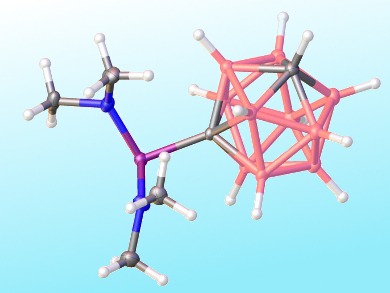Organophosphorus compounds, such as phosphines, phosphine oxides, phosphinates, and phosphonates, have long been established as an important class of ligands for catalysis and have also found usage in herbicides and medicines.
Clara Viñas and colleagues, Institut de Ciència de Materials de Barcelona (ICMAB-CSIC), Bellaterra, Spain, have discovered a new class of phosphorus ligand, in which the carbon linked to phosphorus is not an organic group but belongs to an inorganic boron cluster; a carborane. Carboranes are known to exhibit unusual properties, including low nucleophilicity and toxicity and high chemical and thermal stability.
The team synthesized several of these carboranylphosphinic acids (example pictured), which exhibit high stability against powerful oxidizing agents, owing to the electron-withdrawing nature of the cluster cage. The carborane also influences the pK of the phosphinate, which is significantly more negative than for the phenyl-substituted analogue. Furthermore, the space-filling properties of the carboranyl groups are expected to induce unusual geometric behavior and physicochemical properties in metal complexes, making them an attractive candidate for application in medicine or materials science.
- Carboranylphosphinic acids: a new class of purely inorganic ligands,
Clara Viñas, Elena Oleshkevich, Francesc Teixidor, Duane Choquesillo-Lazarte, Reijo Sillanpää,
Chem. Eur. J. 2015.
DOI: 10.1002/chem.201504408
This article is soon to feature in Chemistry ‒ A European Journal‘s up-coming “Women in Chemistry” special issue.




